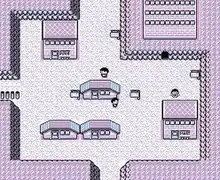Lavender Town
Lavender Town (Japanese: シオンタウン, Hepburn: Shion Taun, Shion Town) is a fictional village in the 1996 video games Pokémon Red and Blue. Stylized as a haunted location, Lavender Town is home to the Pokémon Tower, a burial ground for deceased Pokémon and a location to find Ghost-Type Pokémon.
| Lavender Town | |
|---|---|
 Lavender Town as it appears in Pokémon Red and Blue | |
| First appearance | Pokémon Red and Blue |
| Last appearance | Pokémon: Let's Go, Pikachu! and Let's Go, Eevee! |
| Genre | Japanese role-playing game |
| In-universe information | |
| Other name(s) | Home of Spirits |
| Type | Village |
| Location | Kanto |
The background music of Lavender Town is renowned for adding to the town's creepy atmosphere and in the 2010s, it gave rise to the "Lavender Town Syndrome" creepypasta, a fictional story about hundreds of Japanese children committing suicide after listening to the track.
In the games
Lavender Town is a village that can be visited in Pokémon Red, Green, Blue, Yellow, and sequels Gold, Silver, Crystal, and the remakes thereof. A departure from the typical joyous tone of Red, Green, Blue, and Yellow,[1] it is home to the Pokémon Tower, a graveyard filled with mourning trainers and hundreds of tombstones for deceased Pokémon.[2][3] There the player character can come across the ghost-type Pokémon Gastly and Haunter.[2] The tower is the only place where they are available for capture.[4] During the story of Red, Green, Blue, and Yellow, the player will utilise the item Silph Scope to deal with the ghost-type Pokémon. It is implied that the village is haunted by the spirit of dead Pokémon, in particular a Marowak—murdered by the villainous Team Rocket—searching for its orphaned-Cubone.[5][6] This story is expanded on in the remake Pokémon: Let's Go, Pikachu! and Let's Go, Eevee![5] Lavender Town is the player's first encounter with the concept of Pokémon dying.[6] It is one of a few towns in the Kanto region not to feature a gym.[3]
The Pokémon Tower was replaced by the "Kanto Radio Tower" in Pokémon Gold and Silver. Lavender Town is also home to the "Name Rater", which allows players to change the nickname of their Pokémon, and a care home for abandoned Pokémon.[2]
The Pokémon Tower appears in the episode "The Tower of Terror", the 23rd episode from the first season of the Pokémon anime series, when Ash, Misty, and Brock search for ghost-type Pokémon for the Gym battle against Sabrina. Lavender Town also appears in the Pokémon Adventures and The Electric Tale of Pikachu manga series.[2]
Music

The chiptune background music of Lavender Town in Pokémon Red, Blue, Green and Yellow versions has garnered much interest due to some listeners finding it unsettling. Listing it as the second-most scary video game track in 2012, Brittany Vincent of Bloody Disgusting stated that Lavender Town's "deceptively calm ... tune ranks highly on most gamers' lists of terrifying childhood memories." Lavender Town's music, composed by Junichi Masuda, is deliberately atonal and combines sharp chiptune sounds with "a cavalcade of jarring chords" to create an eerie atmosphere.[7][8] Shubhankar Parijat of GamingBolt included the song on their list of creepy soundtracks in non-horror games.[9] Jay Hathaway of Gawker stated that leaving the music on loop may cause a "vague sense of dread".[10] Kevin Knezevic of GameSpot called it "one of the area's most unforgettable features".[4]
In Pokémon Gold, Silver and Crystal versions (and in their remakes Pokémon HeartGold and SoulSilver), the Lavender Town theme music was recomposed to a happier tone as, per the game's storyline, the Pokémon Tower was demolished and replaced with the Kanto Radio Tower.[11] On YouTube many remixes of the theme have been made.[12] It was re-recorded for the 2017, 2019, and 2020 Pokémon Go Halloween event.[13][12]
Lavender Town Syndrome
In the early 2010s, an urban legend claimed that hundreds of Japanese children had committed suicide in the 1990s as a result of the music in the game, speculating that high pitched tones and binaural beats caused headaches and erratic behavior that led to their deaths.[10] A fabricated illness was dubbed "Lavender Town Syndrome" (as well as "Lavender Town Tone," "Lavender Town Conspiracy," and "Lavender Town Suicides"[14]) and the original story went viral after a creepypasta version of the story was spread on websites such as 4chan. Various people have added details to make the story more convincing over time, such as photoshopping images of ghosts and the Pokémon Unown (spelling out the message "leave now") into spectrogram outputs of the Lavender Town music.[10][12] Certain versions claim that the games’ director, Satoshi Tajiri, wanted the tone in the game to "annoy" children instead of cause harm, while others claim Nintendo was in collaboration with the Japanese government.[14][12]
Reception
Jessie Coello of TheGamer described the story as "one of the creepiest and most infamous creepypastas in online fiction."[12] Mark Hill of Kill Screen stated that the appeal of the Lavender Town Syndrome legend "comes from corrupting such an innocent symbol of childhood."[15] Patricia Hernandez of Kotaku believed that one of the reasons why the Lavender Town creepypasta "is so effective" is that the theme tune is "genuinely creepy."[3] She also noted that the suicides taking place in Japan was an important element in preserving the mystery as fact-checking would require proficiency in Japanese.[3] Nadia Oxford of Lifewire drew comparisons with "Dennō Senshi Porygon", an episode of the Pokémon anime series that gave hundreds of Japanese viewers, most of them children, reactions similar to epilepsy symptoms and sent some into seizures, stating that its fallout "provides a solid bedrock for the Lavender Town myth."[14] Scott Baird of TheGamer believed that the story was "clearly inspired" by the event.[16] Matt Rooney of IGN selected it as one of the best video game urban legends.[17]
Reception and legacy
Eurogamer described Lavender Town as a "standout location" in the original Pokémon games, as it is one of the few locations in the franchise that deals with the fact that the "cute and cuddly" Pokémon could actually die.[18] Rani Baker, writing for Grunge, speculated that this "revelation" is why so many were affected by it.[8] Cian Maher of Bloody Disgusting called the setting "infamous" – "uncanny, weird, and deeply unsettling." He praised the reinvented take in Pokémon: Let's Go, Pikachu! and Let's Go, Eevee!.[5] James Troughton of TheGamer called it "one of the darkest areas of the series" while Jessie Coello, stated that it "birthed some of the most disturbing lore tied to the franchise."[1][12] Patricia Hernandez wrote that "I can’t think of a single thing in Pokémon more unsettling than Lavender Town."[3] Caroline O’Donoghue of The Guardian singled out Lavender Town as an example of the Pokémon series' unique, "half-written, euphemistic" style of story-telling.[6]
In 2018, a line of merchandise was made about Lavender Town.[19]
References
- Troughton, James (2020-03-09). "Pokémon: 8 Things You Never Knew About Lavender Town". TheGamer. Archived from the original on 2020-06-09. Retrieved 2020-09-19.
- Neves, Ravael (2012-02-29). "Stage Select: Lavender Town (Pokémon)". Nintendo Blast (in Portuguese). Archived from the original on 2017-04-20.
- Hernandez, Patricia (2015-10-23). "Pokémon's Creepy Lavender Town Myth, Explained". Kotaku. Archived from the original on 2017-02-25.
- Knezevic, Kevin (November 2, 2018). "New Pokemon Let's Go Trailer Shows Off The Creepy Lavender Town". GameSpot. Archived from the original on 2019-01-27. Retrieved 2020-09-19.
- Maher, Cian (2018-12-29). "[Best of 2018] How 'Pokemon Let's Go' Tames the Horror of Lavender Town". Bloody Disgusting!. Archived from the original on 2018-12-30. Retrieved 2020-09-19.
- O’Donoghue, Caroline (2020-01-27). "What Pokémon can teach us about storytelling". The Guardian. Archived from the original on 2020-08-11. Retrieved 2020-09-19.
- Vincent, Brittany "MolotovCupcake" (2012-07-31). "The 10 Scariest Video Game Music Tracks". Bloody Disgusting. Archived from the original on 2017-04-20.
- Baker, Rani (2017-03-13). "False facts about Pokemon you always thought were true". Grunge. Archived from the original on 2018-06-18. Retrieved 2020-09-19.
- Parijat, Shubhankar (June 10, 2020). "14 Creepy Soundtracks In Non-Horror Games". GamingBolt. Archived from the original on 2020-08-06. Retrieved 2020-09-19.
- Hathaway, Jay (2015-03-12). "Lavender Town: The Bizarre Pokémon Child-Suicide Conspiracy Theory". Gawker. Archived from the original on 2016-10-21.
- "Pokémon: 8 Things You Never Knew About Lavender Town". 9 March 2020. Archived from the original on 2020-06-09. Retrieved 2020-06-09.
- Coello, Jessie (2019-10-30). "Lavender Town: How Pokémon's Notorious Urban Legend Shaped The Entire Franchise". TheGamer. Archived from the original on 2020-09-19. Retrieved 2020-09-19.
- Francisco, Eric (2017-10-18). "Pokémon Go Halloween Event 2017: Are Gen 3 Pokemon Coming?". Inverse. Archived from the original on 2017-11-02.
- Oxford, Nadia (November 18, 2019). "What's Lavender Town Syndrome in 'Pokemon'?". Lifewire. Archived from the original on 2019-11-02. Retrieved 2020-09-19.
- Hill, Mark (2016-02-25). "The Lingering Appeal of Pokémon's Greatest Ghost Story". Kill Screen. Archived from the original on 2016-03-14. Retrieved 2017-04-19.
- Baird, Scott (2019-12-14). "The Ghost Girl In Pokémon Sword & Shield Was Disappointing Due To A Lack Of Mystery". TheGamer. Archived from the original on 2020-01-03. Retrieved 2020-09-19.
- Rooney, Matt (2020-04-29). "The Best Video Game Urban Legends Ever". IGN. Archived from the original on 2020-06-04. Retrieved 2020-09-19.
- Phillips, Tom (2018-10-31). "Just in time for Halloween, here's Lavender Town in Pokémon Let's Go". Eurogamer. Archived from the original on 2020-04-28.
- Clow, Mitchel (2018-08-29). "Lavender Town Pokémon back to school apparel oddly works". Hypable. Archived from the original on 2018-08-29. Retrieved 2020-09-19.
Further reading
- Manzinali, Eymeric. "“Lavender Town Syndrome” Creepypasta: A Rational Narration of the Supernatural". In: Disenchantment, Re-Enchantment and Folklore Genres. Edited by Nemanja Radulović and Smiljana Đorđević Belić. Belgrade: Institute for Literature and Arts, 2021. pp. 217-236.